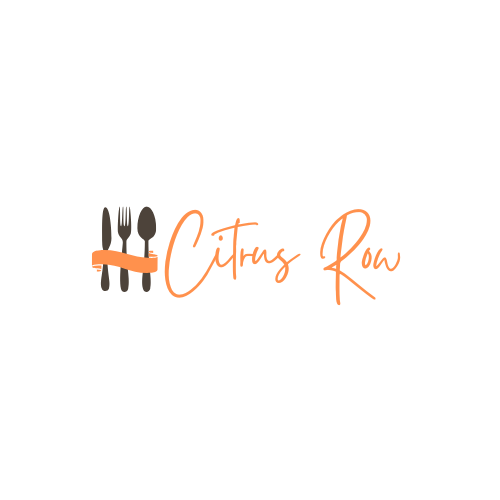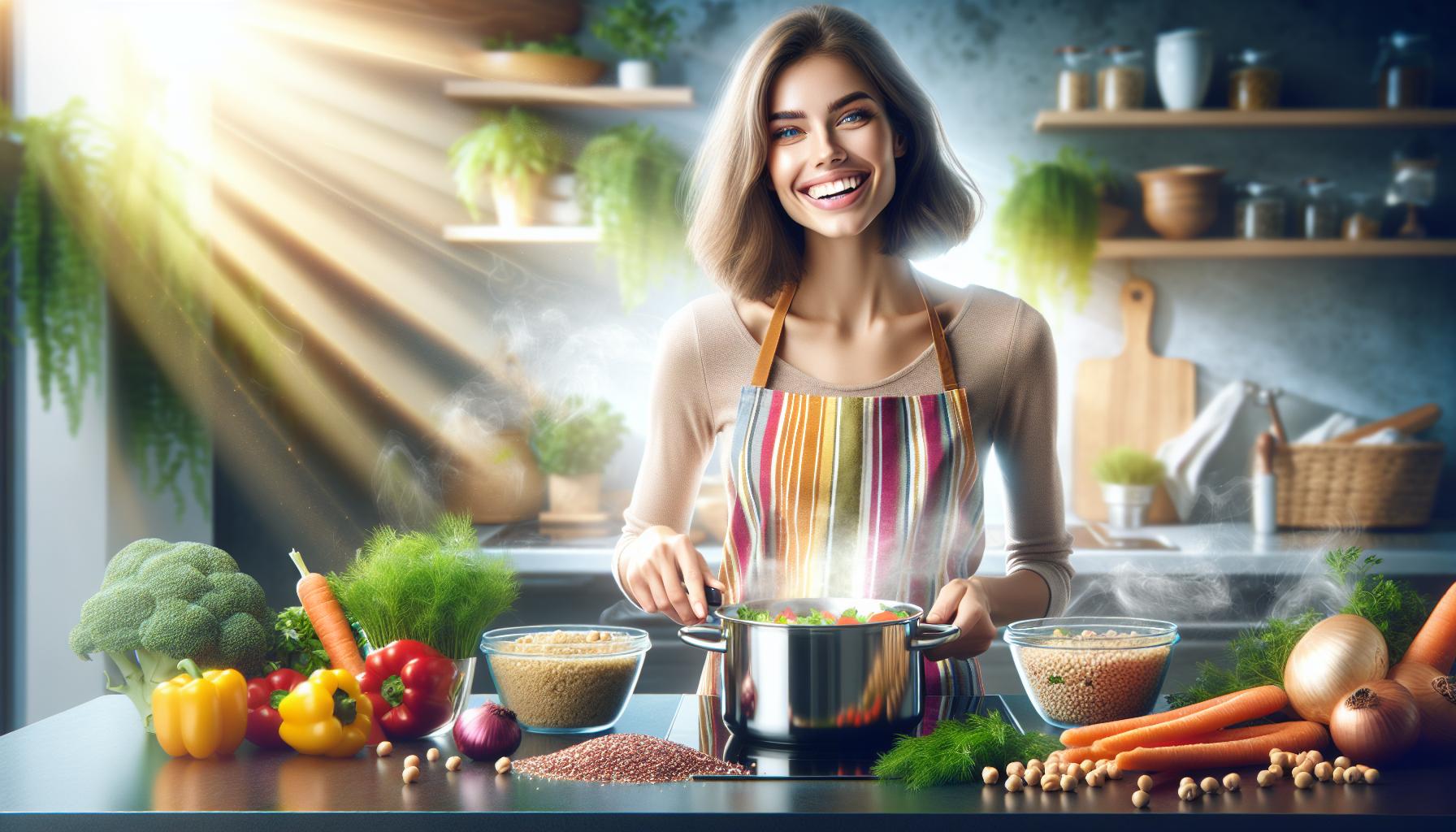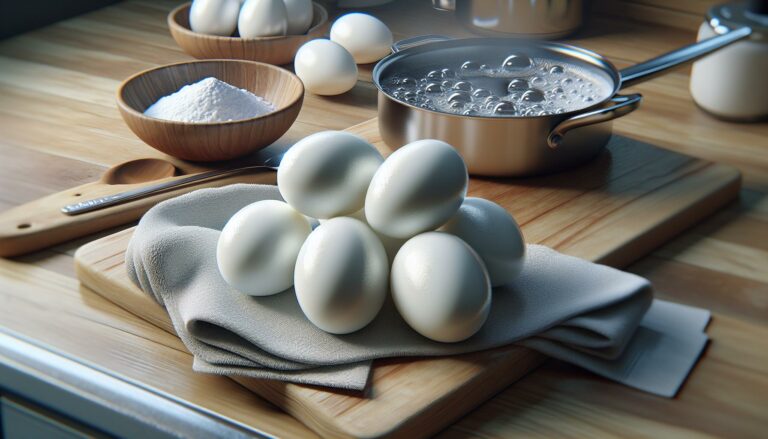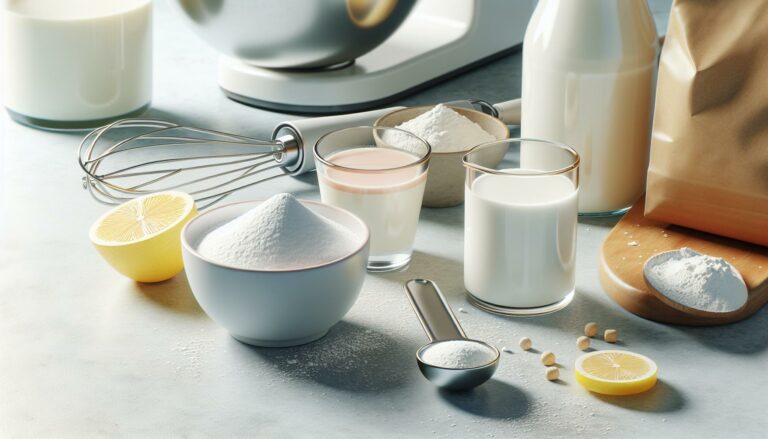Transforming everyday ingredients into nutritious culinary masterpieces doesn’t require a degree from Le Cordon Bleu. In fact mastering healthy cooking techniques can turn anyone into a kitchen superhero without the need for a cape or magical powers.
Today’s health-conscious food lovers are discovering that smart cooking methods can slash calories enhance flavor and preserve vital nutrients. From steaming and grilling to air frying and batch cooking these techniques aren’t just trends – they’re game-changers for anyone looking to maintain a healthy lifestyle without sacrificing taste. The best part? These methods are surprisingly simple to master and they’ll transform ordinary ingredients into extraordinary meals that’ll make taste buds dance and waistlines happy.
Benefits of Healthy Cooking Techniques
Healthy cooking techniques transform ingredients while maximizing their nutritional value. These methods enhance food’s natural flavors without adding excessive calories or unhealthy additives.
Impact on Nutrition
Healthy cooking methods preserve essential vitamins minerals in foods. Steaming vegetables retains up to 90% of their nutrients, compared to boiling which loses 50% of nutrients into cooking water. Raw vegetables maintain enzyme activity crucial for digestion absorption. Grilling meats reduces fat content by allowing excess fat to drip away during cooking. Air frying creates crispy textures using 75% less oil than traditional deep frying methods.
| Cooking Method | Nutrient Retention Rate |
|---|---|
| Steaming | 90-95% |
| Grilling | 85-90% |
| Air Frying | 80-85% |
| Boiling | 40-50% |
Weight Management Advantages
Smart cooking techniques support weight management goals through calorie reduction. Baking poaching eliminate added fats while maintaining moisture flavor. Studies show meals prepared with healthy techniques contain 200-300 fewer calories than traditional cooking methods. A 3-month study of 150 participants revealed those using healthy cooking methods lost 15% more weight than those using conventional cooking techniques. Air frying reduces oil usage by 80% while achieving similar textures to deep-fried foods. Steam-cooking proteins results in 25% fewer calories compared to pan-frying.
| Weight Management Benefits | Statistics |
|---|---|
| Calorie Reduction | 200-300 per meal |
| Oil Usage Reduction | 80% |
| Weight Loss Improvement | 15% |
Essential Tools for Healthy Cooking
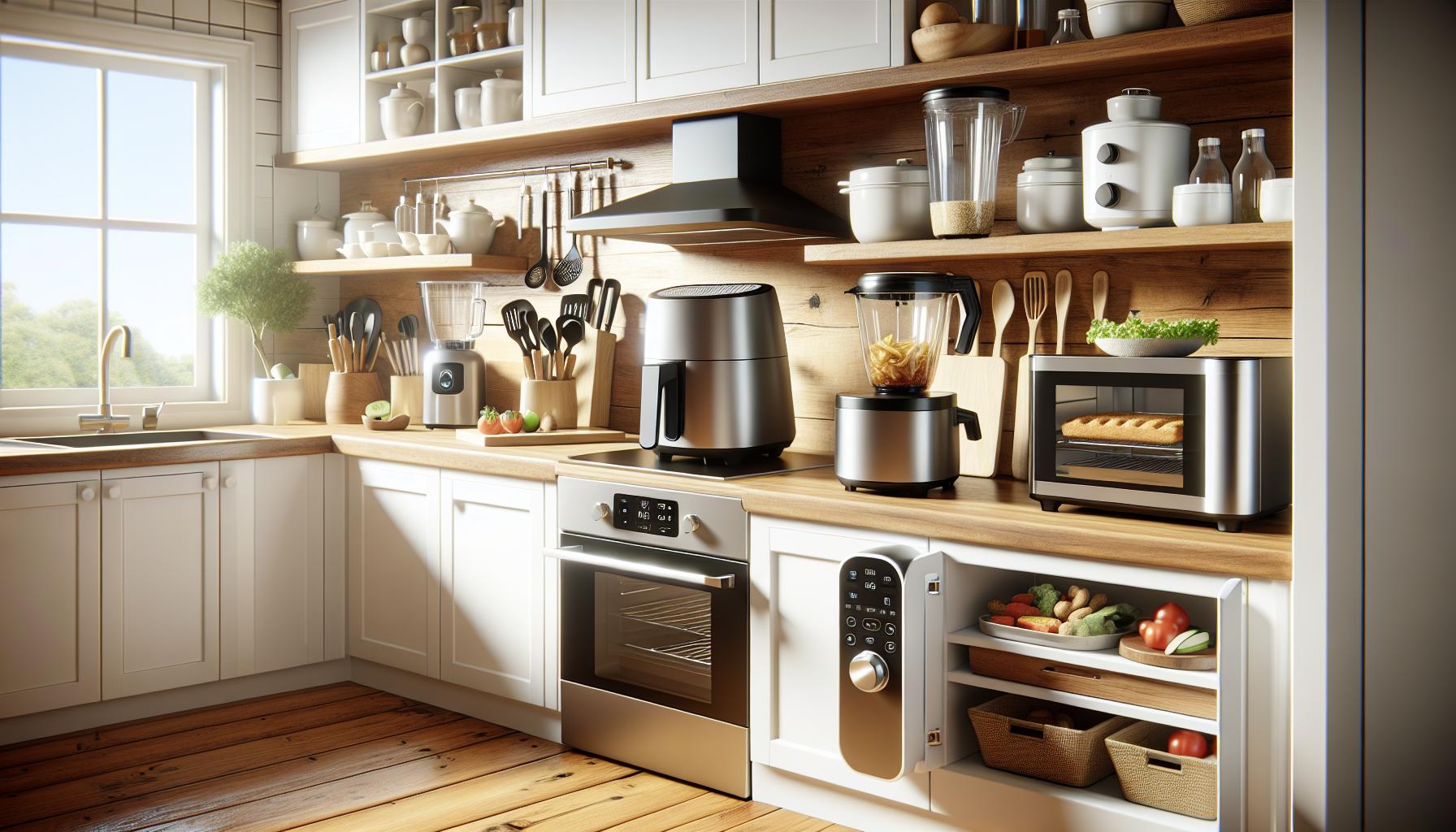
Creating nutritious meals starts with having the right equipment in your kitchen. The proper tools enhance cooking efficiency while supporting healthier preparation methods.
Must-Have Kitchen Equipment
High-quality kitchen equipment forms the foundation of healthy cooking practices. A digital food scale measures precise portions for better portion control. Non-stick ceramic cookware reduces oil usage by 75% compared to traditional pans. Here’s essential equipment with specific benefits:
- Air fryer: Reduces oil consumption by 80% while maintaining crispy textures
- Food steamer: Preserves 90% of vegetables’ nutrients during cooking
- Blender: Creates smooth purees nutrient-rich smoothies in 60 seconds
- Food processor: Chops prepares vegetables 8x faster than manual cutting
- Instant-read thermometer: Ensures safe cooking temperatures within 3 seconds
- Glass storage containers: Maintains food freshness 3x longer than plastic
- Silicone spatulas: Heat resistant up to 600°F prevents scratching cookware
- Stainless steel tongs: Provides precise control for grilling steaming
- Microplane grater: Creates fine garlic ginger zest in 15 seconds
- Glass measuring cups: Ensures accurate liquid measurements within 0.5 oz
- Steel mesh strainers: Removes excess oil reduces fat content by 25%
- Bamboo spoons: Contains natural antimicrobial properties resists bacteria growth
Fundamental Healthy Cooking Methods
Mastering essential cooking techniques creates the foundation for preparing nutritious meals while preserving vital nutrients. These methods minimize added fats while maximizing natural flavors.
Steaming and Poaching
Steaming preserves up to 90% of food nutrients through gentle heat application. A steamer basket placed over boiling water cooks vegetables in 5-7 minutes maintaining their bright colors textures. Poaching involves submerging food in liquid heated to 160-180°F creating tender results without added fats. Fish fillets poach in 8-10 minutes while chicken breasts require 15-20 minutes for safe internal temperatures. Both methods excel at:
- Retaining water-soluble vitamins B C
- Maintaining food’s natural moisture content
- Creating tender textures without oils
- Preserving vibrant food colors
Grilling and Broiling
Grilling imparts smoky flavors while allowing excess fat to drip away from foods. Direct high heat creates appealing grill marks caramelization on meats vegetables in 10-15 minutes. Broiling offers similar benefits using overhead heat inside ovens. Key advantages include:
- Reducing total fat content by 15-25%
- Creating appealing brown crusts
- Achieving proper doneness quickly
- Enhancing natural food flavors
- Fast cooking times under 10 minutes
- Enhanced flavor development
- Minimal oil requirements
- Maximum nutrient retention
- Consistent cooking results
Best Ingredients for Healthy Cooking
Selecting nutrient-rich ingredients forms the foundation of healthy cooking practices. The right ingredients enhance nutritional value while maximizing flavor in health-conscious meal preparation.
Lean Proteins and Fish
Lean proteins serve as essential building blocks for healthy meals. Skinless chicken breast contains 31g of protein per serving with only 165 calories. Wild-caught salmon delivers omega-3 fatty acids plus 22g of protein per 3.5-ounce portion. Greek yogurt packs 23g of protein per cup making it an excellent cooking substitute for heavy cream. Other protein-rich options include:
- Turkey breast (26g protein per serving)
- Cod (20g protein with 85 calories per serving)
- Egg whites (4g protein with 17 calories per serving)
- Tofu (10g protein per 1/2 cup serving)
- Brown rice (3.5g fiber per cup)
- Rolled oats (4g fiber per 1/2 cup)
- Farro (5g fiber per 1/2 cup)
- Chickpeas (12g fiber per cup)
| Ingredient | Protein (g) | Fiber (g) per serving |
|---|---|---|
| Quinoa | 8 | 5 |
| Lentils | 18 | 15 |
| Black Beans | 15 | 15 |
| Chickpeas | 14 | 12 |
Tips for Reducing Fat and Calories
Strategic ingredient substitutions reduce caloric content while maintaining flavor profiles in everyday cooking. These evidence-based techniques create healthier versions of favorite dishes without sacrificing taste.
Smart Oil and Butter Alternatives
Non-stick cooking sprays cut oil usage by 75% compared to traditional methods. Applesauce replaces butter in baking at a 1:1 ratio, reducing fat content by 80% while maintaining moisture. Greek yogurt serves as a protein-rich substitute for sour cream, mayonnaise or heavy cream, offering 70% fewer calories. Mashed avocado creates creamy textures in sandwiches dressings with heart-healthy fats. Vegetable purees (carrots, squash, cauliflower) add moisture to baked goods while reducing fat content by 50%.
| Substitute | Replaces | Calorie Reduction |
|---|---|---|
| Cooking spray | Oil | 75% |
| Applesauce | Butter | 80% |
| Greek yogurt | Sour cream | 70% |
| Purees | Fats | 50% |
Flavor Enhancement Techniques
Fresh herbs intensify flavors without adding calories or sodium. Citrus zest adds bright notes to dishes while containing zero calories. Roasting vegetables concentrates their natural sugars creating deeper flavors. Vinegars infuse dishes with tanginess containing only 3 calories per tablespoon. Spice blends create complex flavor profiles without additional fats or calories. Umami-rich ingredients like mushrooms tomatoes enhance savory notes naturally. Caramelized onions add sweetness depth using minimal oil through slow cooking.
| Technique | Flavor Profile | Calories Added |
|---|---|---|
| Fresh herbs | Aromatic | 0 |
| Citrus zest | Bright | 0 |
| Vinegars | Tangy | 3/tbsp |
| Spice blends | Complex | 0 |
Meal Prep and Planning Strategies
Efficient meal preparation transforms cooking into a streamlined process that saves time and maintains nutritional value. Strategic planning creates a foundation for consistent healthy eating throughout the week.
Batch Cooking Methods
Batch cooking maximizes kitchen efficiency by preparing multiple servings at once. Large-scale preparation of proteins includes cooking 6-8 chicken breasts, 2 pounds of lean ground turkey or 3 pounds of fish fillets simultaneously. Roasting mixed vegetables on 2-3 sheet pans yields 10-12 servings of colorful side dishes. Grain preparation involves cooking 3 cups of quinoa, brown rice or farro to create 6-8 portions. Multiple slow cookers or instant pots enable parallel cooking of soups, stews or legumes. Portioning cooked ingredients into individual containers creates grab-and-go meals that maintain freshness for 4-5 days.
Storage Solutions
Proper storage extends food freshness and prevents nutrient loss. Glass containers with airtight lids preserve prepared meals for 4-5 days in the refrigerator. Mason jars protect overnight oats, parfaits or salads from moisture for 3-4 days. Vacuum-sealed bags extend frozen meals’ shelf life to 3 months while preventing freezer burn. Silicone bags store pre-cut vegetables for 5-7 days while reducing plastic waste. Labels indicating preparation dates track freshness periods accurately. A designated meal prep shelf in the refrigerator organizes containers systematically. Portion-sized containers eliminate guesswork and support consistent serving sizes.
Conclusion
Mastering healthy cooking techniques is a transformative journey that anyone can embrace. These methods not only enhance the nutritional value of meals but also create delicious dishes that support overall wellness. With the right tools efficient meal planning and smart ingredient choices cooking healthy becomes second nature.
The path to better health through cooking doesn’t require culinary expertise – just a willingness to learn and adapt. By incorporating these techniques into daily routines anyone can create nutritious satisfying meals that contribute to their health goals while enjoying the process of cooking.
Embracing these healthy cooking methods isn’t just about following recipes – it’s about making a lasting commitment to better nutrition through mindful food preparation. The journey to healthier cooking starts with a single step and grows into a sustainable lifestyle change.
